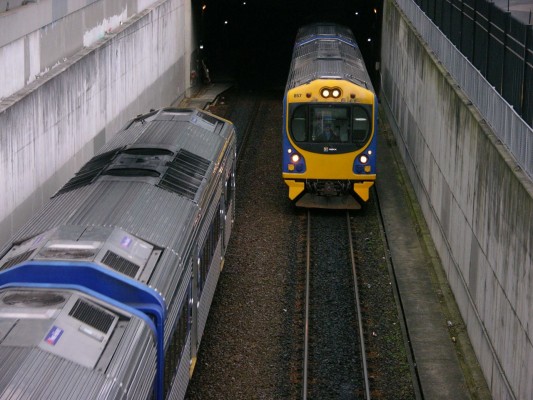Public Support For PPPs
Claims today that we’re happy to have either user pays or private-public partnerships to fund new public transport or roads.
Support was low for government borrowing or raising taxes to pay for new infrastructure, according to research conducted for the New Zealand Council of Infrastructure.
The research, conducted by GA Research and strategic communications firm Kreab Gavin Anderson, will be presented at this week’s NZCID conference on PPPs in Wellington. The research involved focus groups in urban and regional New Zealand and a quantitative telephone survey of 500 people from across the country.
The research explored community reaction to a range of funding options proposed for new infrastructure for public transport and roads. These options include road tolls, petrol taxes and increased council rates.
Asked about these options, some 57 percent preferred a $2 toll on specific motorways and highways. Only nine percent favoured a regional petrol tax, while four percent supported a 20 percent increase in council rates.
The research also found that a significant number of people (24 percent) believed government should be wary of proceeding with projects it did not have the money for.
Asked to choose no more than two preferred ways for government and local councils to pay for new infrastructure such as roads, public transport, ports and utilities, some 40 percent of those surveyed selected user-pays models such as tolls on motorways, while 35 percent opted for PPP projects.
Partial sales of publicly owned assets such as power companies, ports or airports was chosen by 18 percent, while only 10 percent supported further public borrowing and just eight percent supported higher taxes to pay for infrastructure.
NZCID Chief Executive Officer Stephen Selwood said the research had found that most of those surveyed believed that central and local government could not afford to pay for all the community’s infrastructure needs.
“The objective of this research was to understand how people thought we should finance essential new infrastructure - this has been a subject of recent debate and we wanted to understand what funding methods were supported.
“While many of the survey participants had not actively considered this issue previously, once the various options had been explained to them they showed a clear preference for targeted funding methods over blunt instruments such as rates or tax increases,” Mr Selwood said.
Kreab Gavin Anderson Partner and infrastructure specialist Jodie Brough said the focus groups revealed more about the reasons for community attitudes, with concerns about debt, the rising cost of living and the lingering effects of the global financial crisis featuring in respondents’ comments about infrastructure funding.
“People’s minds are very much on the basics at the moment but there is still an appetite for better infrastructure - around one in three respondents said existing roads, rail and other infrastructure across the country was only meeting the needs of some people,” she said.
“This suggests that as confidence in the economy improves, demand for funding solutions will increase. The research indicates that user pays and PPPs remain firmly preferred to broad-based taxes and charges unless powerful arguments can be mounted to persuade the community otherwise.”












3 Comments
Given that NZCI is the head cheerleader for PPPs in NZ, I’m not surprised they achieved this result. I’m sure they didn’t mention the higher lifetime costs of PPP projects against ones funded through sovereign debt, or the “privatise the profits, socialise the losses” model that operates in regard to failures of PPPs.
I wonder what the results would’ve looked like if they’d explained that infrastructure PPPs in Australia have gone bust, with the taxpayer picking up the tab for the guaranteed return that the private partner had in the contract. Or if they’d been told that the experience in the UK with using PPPs for hospital pharmacies is that the lifetime cost could be more than 50% higher with a PPP than through raising sovereign debt.
The money has to come from somewhere, and it’s a hell of a lot cheaper per person if it’s from taxes than from users.
That said, the model I’ve seen suggested for funding the CBDRL where the private partner gets rights over the commercial space in the new stations, is probably workable. Especially if the upper CBD gets rejuvenated by the link’s creation. Right now everything is moving east, to the bottom of Queen Street, to be closer to Britomart. If nothing happens to make the top end of town attractive from a public transport perspective, it’s going to turn into an office slum.
Don’t forget the PPP on the Tullamarine CityLink where the Victorian government contractually couldn’t improve surface routes or public transport options nearby.
Or how like with Brisbane’s tunnels the predicted usage figures were wilder accounting than a Transmission Gully BCR.
And what are the CEOs of Macquarie Bank and it’s subsidiaries earning a year I wonder?
Although I am gladdened by the 57% support for $2 tolls on motorways. There’s the kernel of a good policy right there.
Other Matt (Handlebars Matt? ), if the Tullamarine thing is the Melbourne Airport bus service, that “contractual” aspect is based on the state government’s very conservative (and some say biased) interpretation of a clause that says they’re not allowed to operate a service in competition to the contracted bus service.
), if the Tullamarine thing is the Melbourne Airport bus service, that “contractual” aspect is based on the state government’s very conservative (and some say biased) interpretation of a clause that says they’re not allowed to operate a service in competition to the contracted bus service.
Didn’t Brisbane’s tunnel suffer from very optimistic projections on the impact of the toll? Much like what people are saying will probably happen if Puford is tolled at a level that’s realistic for cost recovery as opposed to a notional toll so that Joyce et al can pretend they’re collecting tolls worth a damn relative to the road’s construction cost.